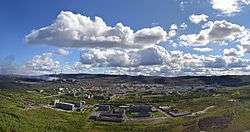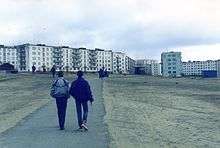Nikel
| Nikel (English) Никель (Russian) | |
|---|---|
| - Urban-type settlement[1] - | |
 mid-July 2011 view of Nikel | |
.svg.png) Location of Murmansk Oblast in Russia | |
 Nikel | |
|
| |
 | |
|
| |
| Administrative status (as of 2011) | |
| Country | Russia |
| Federal subject | Murmansk Oblast[1] |
| Administrative district | Pechengsky District[1] |
| Administrative center of | Pechengsky District[1] |
| Municipal status (as of November 2009) | |
| Municipal district | Pechengsky Municipal District[2] |
| Urban settlement | Nikel Urban Settlement[2] |
| Administrative center of | Nikel Urban Settlement[2] |
| Statistics | |
| Population (2010 Census) | 12,756 inhabitants[3] |
| Time zone | MSK (UTC+03:00)[4] |
| Dialing code(s) | +7 81554 |
|
| |
| Nikel on Wikimedia Commons | |
Nikel (Russian: Ни́кель, lit. nickel; Finnish: Kolosjoki) is an urban locality (an urban-type settlement) and the administrative center of Pechengsky District of Murmansk Oblast, Russia,[1] located on the shores of Lake Kuets-Yarvi 196 kilometers (122 mi) northwest of Murmansk and 7 kilometers (4.3 mi) from the Norwegian border on ![]() . Population: 12,756 (2010 Census);[3] 16,534 (2002 Census);[5] 21,838 (1989 Census);[6] 18,000 (1973).
. Population: 12,756 (2010 Census);[3] 16,534 (2002 Census);[5] 21,838 (1989 Census);[6] 18,000 (1973).
History
In the 1920 Treaty of Tartu, Soviet Russia ceded the area of Petsamo to Finland.[7] In the 1930s huge reserves of nickel were found on fells nearby. The amount was estimated to be five million tons. In 1934, the Finnish Government awarded the mining right to the British Mond Nickel Co, subsidiary of International Nickel Co (Inco), that founded the Petsamon Nikkeli Oy mining company. The company began building a railway, as well as other infrastructure, between the town, then known as Kolosjoki, and Liinahamari harbor.
In the Winter War of 1939–1940, the Soviet Union occupied Petsamo. In the following peace agreement only the Finnish part of the Rybachy Peninsula was ceded to the Soviet Union, although the Soviets had occupied all of Petsamo during the war. In summer 1940, the Finnish government took over the mines from the British company. The first mining operations began in the same year. During World War II, the ore was mainly sold to Germany. The hydro power plant in Jäniskoski started operations in 1942, making it possible to smelt the ore locally.
In December 1943 Albert Speer, German Minister of Armaments and War Production, flew on an inspection tour to Kolosjokki, which by then was the sole supplier of nickel to the Third Reich. Captured during the invasion of Russia, the mines’ ore heaps remained in the yards and had not been shipped out due to a priority of bomb-proofing the power station and smelter. By placing the power plant security on a lower priority, Speer was able to make the transportation shipments of the vital ore to Germany move quicker.[8]
In 1944, the Red Army occupied Petsamo, and Finland had to cede it to the Soviet Union as part of the Moscow Armistice signed on September 19, 1944.[7] Retreating German forces destroyed the power plant and partially the smelter. On July 21, 1945, the Presidium of the Supreme Soviet of the Soviet Union decreed to establish Pechengsky District with the administrative center in Nikel on the ceded territory and to include this district as a part of Murmansk Oblast.[7]
Ecology

The town is linked to the Norilsk Nickel plant nearby where many of its citizens are employed and which causes environmental and health concerns for the population. The nickel smelter which has been an eyesore in Norway–Russia relations for decades due to its extreme pollution levels, usually deposits its sulfur dioxide fumes to the south of the town where the countryside is a brown moonscape of bald hills, barren of plant life for kilometers around.[9] In the summertime, the toxic fumes which for the rest of the year rarely blow northwards towards the town, occasionally do just that, making breathing difficult and even burning holes in people's umbrellas.[9]
Recent events
The video of English alternative rock band White Lies, "Farewell to the Fairground" was filmed there in early 2009.
Sister cities
References

Notes
- 1 2 3 4 5 Государственный комитет Российской Федерации по статистике. Комитет Российской Федерации по стандартизации, метрологии и сертификации. №ОК 019-95 1 января 1997 г. «Общероссийский классификатор объектов административно-территориального деления. Код 47 215», в ред. изменения №259/2014 от 12 декабря 2014 г.. (State Statistics Committee of the Russian Federation. Committee of the Russian Federation on Standardization, Metrology, and Certification. #OK 019-95 January 1, 1997 Russian Classification of Objects of Administrative Division . Code 47 215, as amended by the Amendment #259/2014 of December 12, 2014. ).
- 1 2 3 Law #539-01-ZMO
- 1 2 Russian Federal State Statistics Service (2011). "Всероссийская перепись населения 2010 года. Том 1" [2010 All-Russian Population Census, vol. 1]. Всероссийская перепись населения 2010 года (2010 All-Russia Population Census) (in Russian). Federal State Statistics Service. Retrieved June 29, 2012.
- ↑ Правительство Российской Федерации. Федеральный закон №107-ФЗ от 3 июня 2011 г. «Об исчислении времени», в ред. Федерального закона №271-ФЗ от 03 июля 2016 г. «О внесении изменений в Федеральный закон "Об исчислении времени"». Вступил в силу по истечении шестидесяти дней после дня официального опубликования (6 августа 2011 г.). Опубликован: "Российская газета", №120, 6 июня 2011 г. (Government of the Russian Federation. Federal Law #107-FZ of June 31, 2011 On Calculating Time, as amended by the Federal Law #271-FZ of July 03, 2016 On Amending Federal Law "On Calculating Time". Effective as of after sixty days following the day of the official publication.).
- ↑ Russian Federal State Statistics Service (May 21, 2004). "Численность населения России, субъектов Российской Федерации в составе федеральных округов, районов, городских поселений, сельских населённых пунктов – районных центров и сельских населённых пунктов с населением 3 тысячи и более человек" [Population of Russia, Its Federal Districts, Federal Subjects, Districts, Urban Localities, Rural Localities—Administrative Centers, and Rural Localities with Population of Over 3,000] (XLS). Всероссийская перепись населения 2002 года [All-Russia Population Census of 2002] (in Russian). Retrieved August 9, 2014.
- ↑ Demoscope Weekly (1989). "Всесоюзная перепись населения 1989 г. Численность наличного населения союзных и автономных республик, автономных областей и округов, краёв, областей, районов, городских поселений и сёл-райцентров" [All Union Population Census of 1989: Present Population of Union and Autonomous Republics, Autonomous Oblasts and Okrugs, Krais, Oblasts, Districts, Urban Settlements, and Villages Serving as District Administrative Centers]. Всесоюзная перепись населения 1989 года [All-Union Population Census of 1989] (in Russian). Институт демографии Национального исследовательского университета: Высшая школа экономики [Institute of Demography at the National Research University: Higher School of Economics]. Retrieved August 9, 2014.
- 1 2 3 Administrative-Territorial Division of Murmansk Oblast, p. 54
- ↑ Speer, Albert. 1970. Inside the Third Reich. New York: Macmillan. Page 382.
- 1 2 Antonova, Maria (July 25, 2008). "Balancing Growth and Environment". The Moscow Times. Retrieved 2008-07-25.
- ↑ The model of twin cities Barents Institute Reprint (2008) no. 2
Sources
- Архивный отдел Администрации Мурманской области. Государственный Архив Мурманской области. (1995). Административно-территориальное деление Мурманской области (1920-1993 гг.). Справочник. Мурманск: Мурманское издательско-полиграфическое предприятие "Север".
External links
| Wikivoyage has a travel guide for Nikel. |
- Official website of Nikel (Russian)